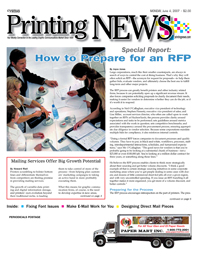|
  June 4, 2007—Fonts. That word strikes fear into the hearts of some designers and print shops, with visions of conflicting versions, missing files, and incorrectly printed pieces dancing before them. But, according to one company, fonts don't have to be something to dread. June 4, 2007—Fonts. That word strikes fear into the hearts of some designers and print shops, with visions of conflicting versions, missing files, and incorrectly printed pieces dancing before them. But, according to one company, fonts don't have to be something to dread.
The latest version of Extensis Suitcase font management software has a variety of new and enhanced features designed to make fonts easy and painless. It provides a way to see, manage, and activate fonts across projects, desktops, and locations if necessary.
For the purposes of this article, I used Suitcase for Windows, in a single license, as opposed to the server version.
Quick and Easy
Starting from a completely unmanaged system, and moving into Suitcase, was quick and fairly painless. The start-up documentation walks you through figuring out which fonts are system fonts, and which can be moved. I put the rest of the fonts into a new folder, and added them to the Extensis software—it was as easy as dragging and dropping.
From there, the rest was automatic. Suitcase deactivated all the fonts I wasn't currently using, and opening and closing Printing News pages was seamless, with the plug-in finding the fonts and managing them without any further interaction on my part.
The only problem encountered was one that was anticipated in the documentation, but, unfortunately, wasn't clearly explained—non-system required fonts that, nevertheless, really need to be activated for Windows to operate properly.
After installing Suitcase, I experienced a few font-related problems in common applications like Internet Explorer. The manual noted that even though they aren't system fonts, some are necessary to prevent exactly these problems. However, the manual used the file name, and not the font name, causing some confusion as to which fonts I needed to have active.
In the end, the problem was fixed by permanently activating the most common fonts found on every computer—Arial, Courier, Times, and Times New Roman, along with a few specific fonts I default to out of preference.
Automatic Activation
One of the most useful features of Suitcase is the automatic font activation and deactivation. The program comes with plug-ins for all the most common page design and layout software programs that use fonts—Adobe InDesign and Illustrator, and QuarkXPress.
When installed the program works in the background; every time you open a document or project in one of those programs, it searches through your font database to match up and activate only those fonts that are being used. And when you close the project, all those fonts are automatically deactivated.
This makes life a little easier, since you always know you have exactly the fonts you need open—and nothing else. Your system memory can be used to do all the other things you need to get done, instead of being dedicated to all those fonts open and running on the machine.
Live Preview
Keeping in mind that I was going from a completely unmanaged system to a managed one, another useful feature in Suitcase was the live preview.
Being able to see the font faces, in every variety, either individually or in groups, was surprisingly useful. It allows for a quick way to spot the font you need for a given project, in a nice-sized window, as opposed to relying on in-program font previews.
One of the nice things about Suitcase is that you can preview all of your fonts—not just the ones that are currently active. So, for those of you with large and varied font collections, this is an easy, one-stop source for browsing fonts without eating system resources.
All in all, Extensis Suitcase is a powerful program. It isn't flashy, and most of the time, after you get it up and running, you won't even notice it is there. However, it will streamline your workflow, and make fonts less of a problem, so you can focus your energy on more important things—the printing.
|


